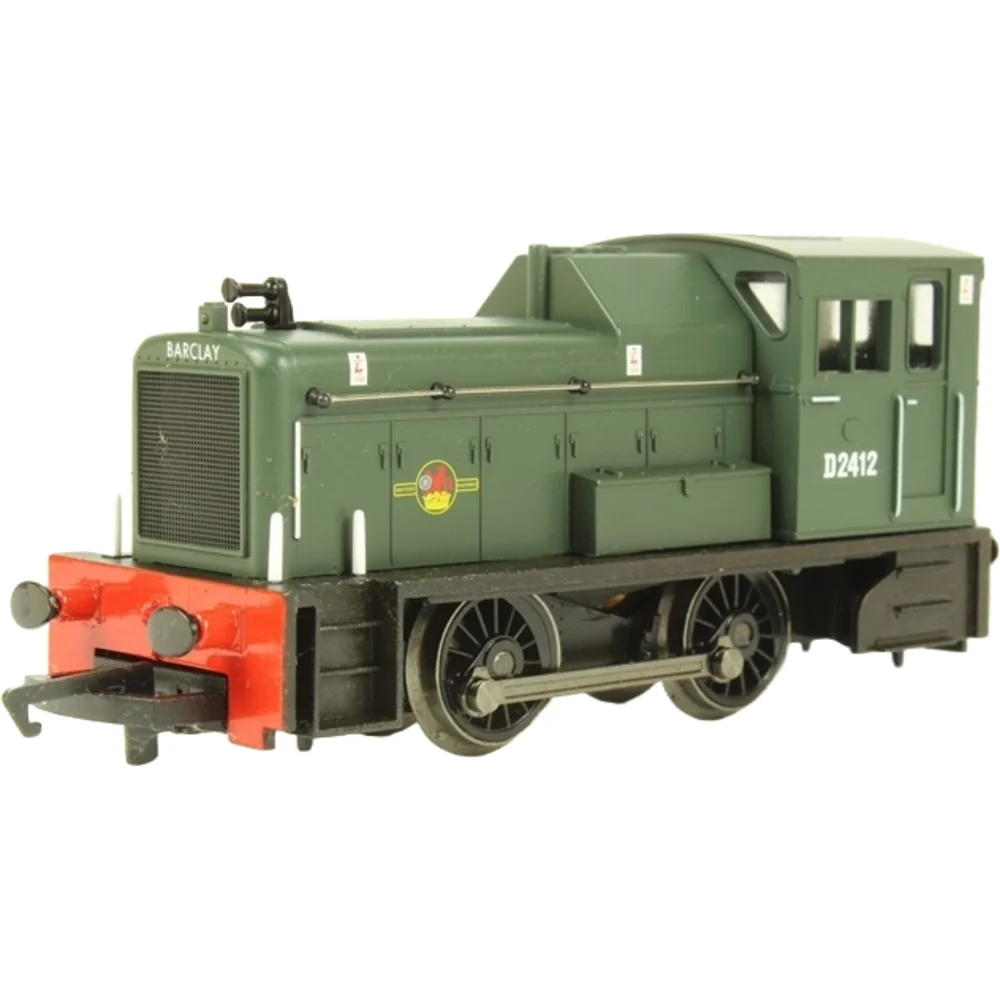Hornby R2188
British Rail Class 06 D2412 British Railways Green with Late Crest
Tooling
Hornby introduced its British Rail Class 06 model in 1988, representing the small 0-4-0 diesel-mechanical shunters built by Andrew Barclay between 1958 and 1960 for the Scottish Region of British Railways. These locomotives were primarily used for yard shunting and short-haul duties. The Hornby tooling was aimed at providing an affordable, entry-level model for OO gauge layouts, and it remained in production for many years across various ranges, including the Railroad series.
Tooling Features
- Construction: Pre-assembled plastic bodyshell with factory-fitted details; lightweight chassis
- Detailing: Separate handrails, bufferbeam detail (detailing pack), cab glazing, basic footplate and interior detail
- Couplings: Standard Hornby tension-lock couplers, fixed mountings
Mechanical & Electrical
- Drive: 0-4-0 configuration, 2 driven axles
- Pickups: All wheels, 2-rail DC
- Weighting: Incorporated within chassis
- Lighting: None
- Performance: High top speed, limited slow-speed control
DCC Capability
DCC compatible but no factory socket; conversion requires hard-wiring. No sound provision.
Liveries Produced
BR Green (late crest), BR Blue, Departmental Grey, Civil Engineers ‘Dutch’, Virgin Trains, Private Owner schemes, and special editions such as Pullman and Robert Horne Paper Co.
Reviews & Commentary
Praised for affordability and suitability for beginners. Criticised for limited detailing, unrealistic speed, and light weight. Later Railroad versions improved slightly but remain basic compared to modern standards.
Interesting Notes
The tooling appeared in starter sets and budget ranges for decades. Popular for kitbashing. Prototype 06003 is preserved at the Museum of Science & Industry in Manchester.
Class & Prototype
- Class: British Rail Class 06
- Traction: Diesel
- Transmission: Mechanical
- Built: 1958-1960
- Total Built: 35
- Running Number: D2412
- Name: -
- Ordered By: British Railways
- Built By: Andrew Barclay Sons & Company
- Built At: Kilmarnock
- Built: 09/1958
- Withdrawn: 06/1968
- Length of Service: 9.8 years
- Running Numbers: BR D2412
- Names: -
Operator & Livery
- Operator: British Railways
- Livery: Green with Late Crest
British Railways transformed Britain's fragmented rail network into a unified national system following nationalisation on 1st January 1948. Created from the "Big Four" companies under the Transport Act 1947, BR operated most of Great Britain's railways until rebranding as British Rail in 1965, managing over 20,000 route miles and inheriting nearly 20,000 locomotives of diverse designs.
The organisation pioneered standardisation through its revolutionary BR Standard locomotive programme (1951-1960), producing 999 advanced steam engines under Robert Riddles' direction. These included the versatile Britannia Pacifics, mighty 9F freight engines, and mixed-traffic classes that incorporated the best features from all predecessor companies. The 1955 Modernisation Plan accelerated diesel and electric traction development, creating fascinating mixed-traction operations.
Notable achievements included establishing unified locomotive classification systems, introducing distinctive corporate liveries, and managing the complex transition from steam to modern traction. BR's six regional structure preserved operational diversity whilst enabling standardisation of practices, signalling, and rolling stock that had eluded private enterprise for over a century.
The BR era represents steam traction's final flowering alongside emerging diesel technology, creating unparalleled locomotive variety. Today, this heritage remains highly popular with railway enthusiasts through extensive preserved fleets, heritage railway operations, and comprehensive model ranges from manufacturers like Hornby, Bachmann, and Dapol, making BR subjects essential for authentic post-war British railway modelling across all scales.
